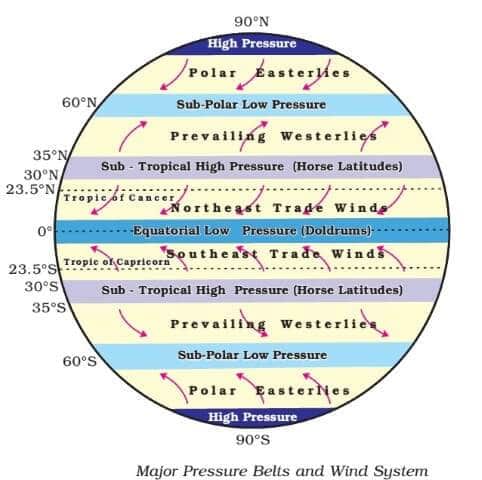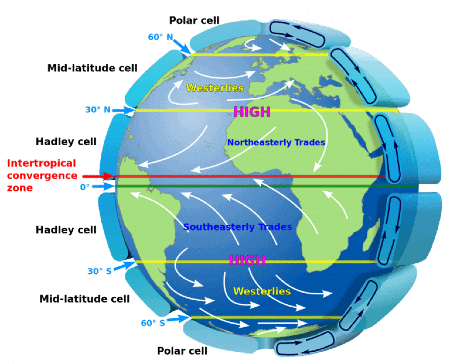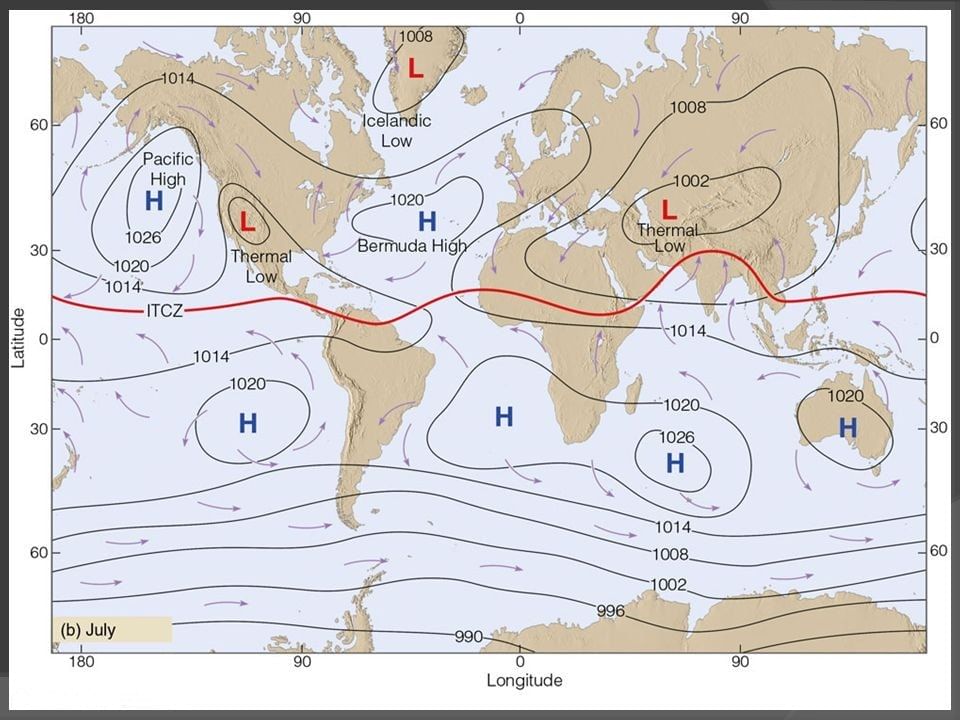Pressure Belts of the Earth | Geography for UPSC CSE PDF Download
| Table of contents |

|
| Pressure |

|
| Factors Controlling Pressure Systems – |

|
| World Pressure Belts |

|
| Pressure belts in July |

|
| Pressure belts in January |

|
Pressure
- A column of air exerts weight in terms of pressure on the surface of the earth.
- The column of air's weight at a given place and time is called air pressure or atmospheric pressure.
- An instrument measures atmospheric pressure called a barometer.
- Atmospheric pressure is measured as force per unit area. The unit used for measuring pressure is called millibar.
- One millibar is equal to the force of nearly one gram per square centimetre.
Factors Controlling Pressure Systems –
There are two main causes, thermal and dynamic, for the pressure differences resulting in high and low-pressure systems.
Thermal Factors
- When air is heated, it expands and, hence, its density decreases. This naturally leads to low pressure; on the contrary, cooling results in contraction. This increases the density and thus leads to high pressure.
- Formation of equatorial low and polar highs are examples of thermal lows and thermal highs, respectively.
Dynamic Factors
- Apart from variations of temperature, the formation of pressure belts may be explained by dynamic controls arising out of pressure gradient forces and rotation of the earth (Coriolis force).Question for Pressure Belts of the EarthTry yourself:Atmospheric pressure is measured byView Solution
What is a Pressure Gradient?
- The rate of change of atmospheric pressure between two points on the earth’s surface is called the pressure gradient.
- On the weather chart, this is indicated by the spacing of isobars.
- Close spacing of isobars indicates a strong pressure gradient, while wide spacing suggests a weak gradient.
➤ Vertical Distribution
- The columnar distribution of atmospheric pressure is known as the vertical distribution of pressure.
- The mass of air above in the column of air compresses the air under it. Hence, its lower layers are denser than the upper layers; Thus, the lower layers of the atmosphere have higher density, therefore, exert more pressure.
- Conversely, the higher layers are less compressed and, hence, they have low density and low pressure.
- The air temperature, the amount of water vapour present in the air, and the gravitational pull of the earth determine the air pressure of a given place and at a given time.
- Since these factors vary with a change in height, there is a variation in the rate of decrease in air pressure with an increase in altitude.
- Rising pressure indicates fine, settled weather while falling pressure indicates unstable and cloudy weather.
➤ Horizontal Distribution
The factors responsible for variation in the horizontal distribution of pressure are as follows:
- Air temperature – Equator Polar regions
- The earth’s rotation – Coriolis force
- Presence of water vapour – Inversely related to pressure
Air Temperature
- Earth is not heated uniformly because of unequal distribution of insolation, differential heating and cooling of land and water surfaces.
- Air pressure is low in equatorial regions, and it is higher in the polar areas.
- Low air pressure in equatorial regions is because hot air ascends there with a gradual decrease in temperature, causing thin air thinness on the surface.
- In the polar region, cold air is very dense; hence it descends, and pressure increases.
The Earth’s Rotation
- The earth’s rotation generates centrifugal force.
- This results in the deflection of air from its original place, causing a decrease of pressure.
- The low-pressure belts of the subpolar regions and the high-pressure belts of the sub-tropical regions are created due to the earth’s rotation.
Presence of Water Vapour
- Air with a higher quantity of water vapour has lower pressure, and that with a lower amount of water vapour has higher pressure.
World Pressure Belts
On the earth’s surface, there are seven pressure belts. They are –
- Equatorial Low
- The two Sub-tropical Highs
- The two Sub-polar Lows
- The two Polar Highs.
Equatorial Low Pressure Belts
- This low-pressure belt extends from 0 to 5° North and South of the Equator.
- Due to the vertical rays of the sun here, there is intense heating. The air, therefore, expands and rises as convection current causing low pressure to develop here.
- This low-pressure belt is also called doldrums because it is a total calm zone without any breeze.

➤ Sub-tropical High Pressure Belts
- At about 30°North and South of the Equator lies the area where the ascending equatorial air currents descend. This area is thus an area of high pressure.
- It is also called as the Horse latitude.
- Winds always blow from high pressure to low pressure.
- So, the subtropical region's winds blow towards the Equator as Trade winds and another wind blow towards Sub-Polar Low-Pressure as Westerlies.
➤ Circum-polar Low Pressure Belts
- These belts located between 60° and 70° in each hemisphere are known as Circum-polar Low-Pressure Belts.
- In the Sub-tropical region, the descending air gets divided into two parts.
- One part blows towards the Equatorial Low-Pressure Belt. The other part blows towards the Circum-polar Low-Pressure Belt.
- This zone is marked by the ascent of warm Sub-tropical air over cold polar air blowing from poles. Due to earth’s rotation, the winds surrounding the Polar region blow towards the Equator.
- Centrifugal forces operating in this region create the low-pressure belt appropriately called Circum-polar Low-Pressure Belt.
- Violent storms mark this region in winter.
➤ Polar High Pressure Areas
- At the North and South Poles, between 70° to 90° North and South, the temperatures are always shallow.
- The cold descending air gives rise to high pressures over the Poles.
- These areas of Polar high pressure are known as the Polar Highs.
- Permanent IceCaps characterise these regions.
- Question for Pressure Belts of the EarthTry yourself:Which layer of atmosphere is responsible for Aurora
Borealis?
View Solution
The Coriolis Effect

- The Coriolis deflection sets the major constraint on how many cells the atmosphere of a planet divides into. Coriolis force is stronger for more rapid rotation. It is the size of the earth and speed of rotation (and a lesser extent, the depth of the atmosphere) which determines how many of these atmospheres divides into three cells.
- For Jupiter, it is many more, as it is 12 times larger in diameter and yet has a day only 12 hrs long. Coriolis Force is very strong.
Atmospheric Circulation
Atmospheric circulation is the large-scale movement of air, and together with ocean circulation, thermal energy is redistributed on the surface of the Earth.
Latitudinal circulation – The wind belts girdling the planet are organized into three cells in each hemisphere—the Hadley cell, the Ferrel cell, and the polar cell. Those cells exist in both the northern and southern hemispheres.
Longitudinal circulation (Walker circulation) – Latitudinal circulation results from the highest solar radiation per unit area (solar intensity) falling on the tropics. The solar intensity decreases as the latitude increases, reaching essentially zero at the poles.
Longitudinal circulation, however, is a result of the heat capacity of water, its absorptivity, and its mixing. Water absorbs more heat than the land, but its temperature does not rise as great as the land. As a result, temperature variations on land are greater than on the water.
➤ The Hadley Cell
- Solar heating at the equator is strongest, causing rising convective air pushed north and south at the tropopause (troposphere/stratosphere boundary).
- At ~30deg latitude it has deflected enough by the Coriolis force to be moving almost due east. Here, it meets air moving down from the north (Ferrel Cell air) and meets and descends, warming and drying.
- The air's return, now a surface wind, to the equator is called the “trade winds”.

➤ Mid-latitudes – The Ferrel Cell
- Convective rising air near 60 deg latitude arrives at the tropopause, moves (in part) to the south, deflecting Coriolis to the west, till it meets the northerly moving air from the tropical Hadley cell, forcing both to descend.
- These are the “Horse Latitudes” at +-30 deg latitude. Descending air dries. Deserts here (e.g. Sahara, Mojave/Sonora)
- Northerly moving surface winds deflected east – “the Westerlies” – carrying heat from the lower latitudes to higher mid-latitudes
- The primary circulation on Earth is driven by the equatorially heated Hadley Cell and the polar cooled Polar Cell. The Ferrel cell is a weaker intermediate zone, in which weather systems move through driven by the polar jet stream (the boundary between Ferrel and Polar cell, at the tropopause) and the tropical jet stream (the boundary between Ferrel and Hadley cells, at the tropopause).
- The jet streams have irregular paths as the convective instabilities migrate, and these drive the many cold and warm fronts which move through the Ferrel Cell.
➤ The Polar Cell
- Easiest of the cells to understand – rising air from the 60-degree latitude area in part moves north to the pole, where it’s cold enough to densify, converge with other northerly winds from all longitudes, and descends.
- This makes a “desert” at the north and south poles. Question for Pressure Belts of the EarthTry yourself:Horse latitudes lie within the atmospheric pressure belts ofView Solution
➤ Walker circulation
- The Southern Hemisphere has a horizontal air circulation cell called Walker Cell responsible for upwelling along the South American Coast and bringing rains in Australia.
- The Walker circulation results from a difference in surface pressure and temperature over the western and eastern tropical Pacific Ocean. A pressure gradient from east to the west creates an air circulation from the Eastern pacific (i.e. along the coast of Peru-Chile) to the western Pacific (Australia-New Guinea). This air circulation displaces surface water towards the western pacific, causing cold water from beneath the ocean to move upward.
- Surface waters of the ocean are warm, and the water under oceanic beds is cold and contains various types of nutrients that help aquatic life. Sea bird along the coast of South America (eastern pacific) gets plenty of Phytoplankton and produces Guano, which again helps aquatic life. So, fishing is a thriving occupation along the eastern coast of South America.
- The western pacific and Australia receive precipitation due to Walker circulation.
- On the other hand, When the Trade Winds are weak, the central Pacific Ocean's warm water slowly drifts towards the South American coast and replaces the cool Peruvian current. Such an appearance of warm water off the coast of Peru is known as El Nino.
- The El Nino event is closely associated with the pressure changes in the Central Pacific and Australia. This change in pressure conditions over the Pacific is known as the southern oscillation.
- The combined phenomenon of southern oscillation and El Nino is known as ENSO.
- In the years when the ENSO is strong, large-scale variations in weather occur over the world. The arid west coast of South America receives heavy rainfall, drought occurs in Australia, and sometimes in India, and floods in China. This phenomenon is closely monitored and is used for long-range forecasting in major parts of the world. (El-Nino in detail later)
Pressure belts in July
- In the northern hemisphere, during summer, with the sun's apparent northward shift, the thermal equator (belt of highest temperature) is located north of the geographical equator.
- The pressure belts shift slightly north of their annual average locations.

Pressure belts in January
- These conditions are completely reversed during winter, and the pressure belts shift south of their annual mean locations. Opposite conditions prevail in the southern hemisphere. However, the amount of shift is less in the southern hemisphere due to the predominance of water.
- Similarly, the distribution of continents and oceans have a marked influence on the distribution of pressure. In winter, the continents are cooler than the oceans and tend to develop high-pressure centres, whereas, in summer, they are relatively warmer and develop low pressure. It is just the reverse with the oceans.

|
175 videos|477 docs|193 tests
|
FAQs on Pressure Belts of the Earth - Geography for UPSC CSE
| 1. What are pressure systems? |  |
| 2. How do pressure belts control weather patterns? |  |
| 3. What are the world pressure belts? |  |
| 4. How do pressure belts vary in different months? |  |
| 5. How do pressure belts affect wind patterns? |  |

|
Explore Courses for UPSC exam
|

|

















